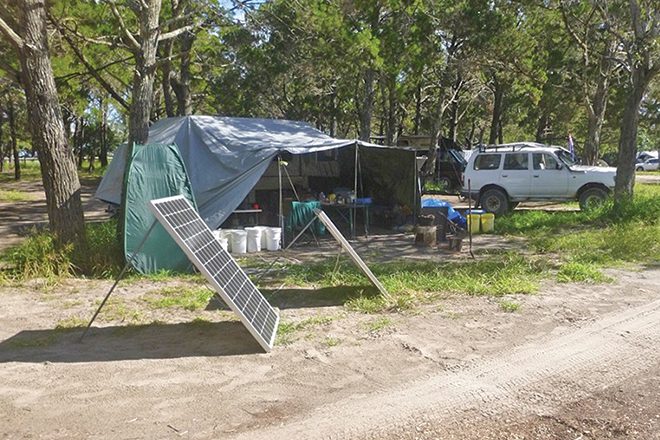
HI all, after playing around with solar equipment for camping for about seven years, I have a good understanding of what you need for all-weather base camp-style camping.
I started out years ago with just two 120W fold-out 12V panels hooked together to make 240W and one PWR controller. For storage I had three 70A four-wheel-drive batteries, as I was told that would be heaps.
During my first camp at Pennefather River everything was going great until I noticed the batteries were not getting charged enough, so for the next two weeks I had to run my 1.5kVA generator with my 16A battery charger plugged into and charging the three batteries for four to six hours a day just to keep the freezer going.
By the way, my main freezer is about 25 years old. It’s a 100-litre 75mm insulated Trailblaza single compressor that burns 7A of power when running, with no digital display and nothing much to go pear shaped. On that trip alone it cost me another $400 in unleaded fuel.
The next year after talking to experts who said my batteries were not good enough I borrowed two new 120A AGM batteries off my mate and set up camp at Penny again. After a week I noticed the batteries were not staying charged, even with the panels sitting in the sun for seven to eight hours.
I got talking to another camper who advised I move the controller from the back of the panel to right up near the batteries. That made sense because I was getting too much voltage drop from the controller to the batteries. I could do this because I had all my 6mm tinned cables with Anderson plugs on the ends.
That made a big difference but I still had to run the generator for four to six hours a day to charge the batteries. That trip cost $500 for unleaded fuel. I starting thinking the solar panels were not big or good enough, even though experts told me they would be heaps.
Anyway, I started reading fishing forums to get an idea of what other people were doing, and began trying different panels. One bloke had just bought two 240W, 60V second-hand house solar panels to set up an off-grid solar arrangement on a camping shed on his bush block where he hunted deer.
He had bought two Victron 75/15 MPPT controllers online, a heap of 6mm twin-core wire and three 120A AGM batteries. He hooked it all up and was getting up to 30A of power in good winter sun. I thought that was unreal, as I was only getting about 8A from brand-new panels in hot sun up north.
So I got online and bought two Victron 75/15 MPPT controllers off a mob on the Gold Coast and a heap of Anderson plugs from Jaycar, along with 40m of 6mm tinned marine wire because I camp on the beach and it doesn’t corrode as much.
It took me a few weeks to track down a second-hand 240W, 60V house panel a mate had but couldn’t find another one, so had to buy a 180W, 30V model. So far I had spent nearly $500 and still needed new batteries.
Luckily my mate could get them at cost, so this time I bought four 120A AGM batteries that cost $940.
So for $1440 I was away. The only downside to this whole setup is it weighs about 160kg. However, contrast that with a new 2kVA Honda generator, leads, lights, two 20A battery chargers and two or three 20-litre jerry cans of fuel and you’d be at around 130kg.
I should get six or more years out of my batteries and six years of running the generator would cost about the same in fuel and oil as it would to buy new batteries. Next time I will buy lithium batteries as they will add up to about 40kg, not 123kg.
In national parks where you can’t run a generator, I’m ahead as I have a super-quiet camp. Anyway, after soldering all the 6mm cables and Anderson plugs together and hooking it up at home to see if it worked, finally we headed to Penny for our month-long fishing trip.
I hooked it up to the fully loaded 100-litre Trailblaza on freeze and over the next three to four weeks all I did, once a day, was shift the panels to keep them facing the sun. The setup was making up to 25A most days out of 12-year-old house solar panels and the batteries were on float by 1pm.
Other campers were having trouble with their solar gear not working and coming and looking at my setup, which they said was unreal. This year’s camping trip to Inskip Point didn’t feature the best weather. However, despite pouring rain overnight and no sun until 9-10am the next morning, my setup still made 20-23A of power.
My van was in the shade and my higher-voltage house panels were 20-40m away and still had plenty of volts to run the controllers because they were in great sunshine. About 95 percent of other campers had to run their generators for four to six hours a day because their solar was just not good enough or was mounted on the roof of their van in the shade.
I’m glad it only took me seven years to get that sorted.
‘Til next month, safe travels.
For more Craig Tomkinson DIY, click here!
Craig Tomkinson
 Bush ‘n Beach Fishing Magazine Location reports & tips for fishing, boating, camping, kayaking, 4WDing in Queensland and Northern NSW
Bush ‘n Beach Fishing Magazine Location reports & tips for fishing, boating, camping, kayaking, 4WDing in Queensland and Northern NSW









